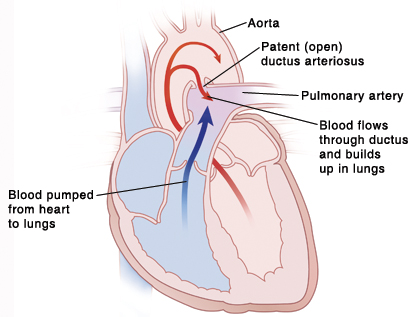Patent Ductus Arteriosus (PDA) in Premature Infants
Patent Ductus Arteriosus (PDA) in Premature Infants
Your infant has been diagnosed with a patent ductus arteriosus (PDA). The ductus arteriosus is a normal structure in a fetus’ heart before birth. It’s a blood vessel that connects 2 arteries: the pulmonary artery and the aorta. The pulmonary artery carries blood from the heart to the lungs. The aorta carries blood from the heart to the body. Before birth, the ductus arteriosus allows blood from the right ventricle to bypass the lungs because the fetus gets oxygen from the mother. The ductus arteriosus normally closes shortly after birth once the baby breaths on its own. It’s called a PDA when it stays open (patent). A PDA can lead to worsening heart function over time. But it can be easily treated. In the United States, this is a fairly common congenital (present at birth) heart defect. A PDA is more common in premature infants, but can also be seen in full-term infants. It may be associated with other congenital heart defects. It is more common in girls.
When is the PDA a problem?
A PDA that remains open beyond a few days after birth can strain the heart and increase the blood pressure in the lungs. This can causes pulmonary congestion (fluid buildup in the lungs) and may make it hard for the baby to breathe. The heart also has to work harder.
How is PDA diagnosed?
The problem can be detected with an echocardiogram (ultrasound imaging test of the baby’s heart). In mild cases, there may be no symptoms. Or symptoms can include:
A heart murmur
Heart palpitations
Abnormal blood pressure
Pulses that are stronger than normal in the upper part of the body and diminished or absent in the legs
Low oxygen levels in the legs and lower body
Signs of heart failure, such as sweating during feeding or poor weight gain
Rapid or trouble breathing
How is PDA treated?
The ductus may close on its own, without treatment. If it doesn’t, treatments include:
Medicine. Certain medicines, such as non-steroidal anti-inflammatory drugs or NSAIDs, can constrict the artery, shrinking the duct and allowing it to close. The medicine is given by IV over a period of a few days. During this time, the baby is monitored closely.
Catheter based procedure. This is usually reserved for older babies. This may be done on a small to moderate sized PDAs if the treatment with medicine did not work. Children must be large enough to qualify for the procedure. Through a catheter (long thin tube) inserted into a larger artery in the leg, a small metal coil, or device is advanced to the PDA and placed like a plug to block blood flow between the vessels. The coil or device is released and remains there permanently.
Surgery. This may be done if your baby can’t tolerate the medicine, or if treatment with medicine has not worked. Typically it is reserved for children who are too small for a catheter-based procedure, or if a catheter-based procedure was not successful. The surgeon may advise surgery if other related congenital heart defects require surgery. The surgeon makes an incision between the ribs on the left side of the chest and clamps or ties off the opening in the blood vessel. The surgery doesn’t involve the heart muscle. This surgery has a high success rate and a low risk of complications.
What are the long-term effects?
Once the ductus is closed, there are rarely long-term complications. After closure using catheter based procedures, preventive antibiotics are gives for 6 months to prevent infection. Ask your cardiologist about what activities are safe for your baby.
Updated:
October 06, 2017
Sources:
Management of patent ductus arteriosus, Up To Date, Up To Date. Clinical Manifestations and Diagnosis of Patent Ductus Arteriosus
Reviewed By:
Ayden, Scott, MD,Bass, Pat F. III, MD, MPH,Image reviewed by StayWell medical illustration team.
